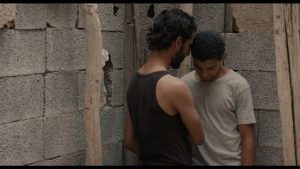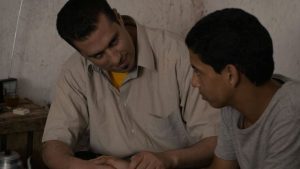Summary:

Abedellah Taïa’s first film, Salvation Army, is an autofictional account of the author/director’s adolescence growing up as a queer youth in Casablanca. Hailed as the first film focusing on same-sex desire from a predominantly Muslim and Arabic-speaking country, Taïa’s cinematic work has important socio-political implications coming from a country in homosexuality is viewed as “haram”—taboo—but also because such sexual orientation is criminalized. In 2013, the Atlantic, a popular United States magazine, wrote that in an edition of the Venice Film Festival notable for the prevalence of works grappling with global and societal woes (unemployment, terrorism, pollution, war) perhaps no film blended the personal and the political as strikingly as Abdellah Taia’s L’Armée du salut (Salvation Army). Salvation Army observes the adolescent protagonist’s sexual awakening, as he meets with men in shadowy alleys and empty lots, careful not to be discovered in a country where homosexuality is a crime punishable by prison time. The film’s final section finds Abdellah living in Switzerland 10 years later, free from the severe restrictions of Moroccan society, but nostalgic for his native land.
While this film played mostly at LGBTQ film festivals and art houses and never showed in Morocco, it is nonetheless an important film in the ways that it speaks to cultural locations and dislocations as various queer communities of all kinds emerge and challenge more Western monolithic notions of queerness and its phenomenological experiences. It not only adds to a global discussion about sexual identities and kinship networks but it also implicates real and imagined borders—geographic and cultural— that confine, configure, and conscript.
Philosophers such as Michel Foucault and, more recently, Maria Pia Lara, have theorized about marginalized communities’ ability to portray their realities, whether they be dissident sexual communities, women, or ethnic minorities, without their voices being disfigured or compromised by their relation to the power and signifying systems that others them. These dissonant voices and depictions work to reformulate and challenge the predominant cultural discourses that underpin the values, beliefs, and social boundaries of heterocentric societies. It is precisely these complex social dynamics that Taïa seeks to engage through the representations of Abdellah’s tumultuous adolescence and early adulthood. His goal is to mediate a Moroccan social/cinematic space that reflects back to Moroccan audiences as well as a wider world audience the realities of gay youth that grow up in a culture that is so prohibitive and secretive about same-sex attraction.

Growing up in Casablanca as a gay youth, Abdellah is in love with his oldest brother, about whom he fantasizes while sneaking into his brother’s room to lie in his bed or sniffing his underwear. Along with experiencing his burgeoning desire for his brother, Abdellah also begins to discover trade routes for sexual tourism and to navigate the sexual dynamics and codes with other closeted Moroccans. Thus, Taia utilizes the film’s narrative to illustrate the acquisition of different types of queer knowledge that complicate national narratives surrounding sexuality. Some critics have argued that the film’s protagonist is “neither a victim nor oppressed by the socio-economic and patriarchal conditions of his existence but rather that his sexuality is “naïve and perverse, exploited and exploitative.” (Georgis, 1). A reading of the film without consideration of Taïa’s written works or interviews may seem justified in light of the film’s stark silences and emotional restraint. Taïa tells quite a different story in interviews:
“What destroyed me, killed me, was when I discovered that no one will help me,” he says. “The society wants to rape me, men were harassing me, some others insulting, touching, and I was the one always condemned. People felt they had the right to exploit me sexually. All the neighborhood knew. Even my family knew. But they abandoned me. This was very cruel. Very tragic. I always felt and I am still feeling that way attached to my family, to the poor class, to our poor imagination, our poor situation.” (Dehghan, N.p)
Thus, Taïa meant for Salvation Army to be a very conscious challenge to Moroccan society. Although this film is based on an autobiographic work, Taïa wanted to objectify his story so that it became more than just his story. This meant that he had to find not only the right critical distance but also to find the appropriate images to convey the hard reality of Morocco and the silences it imposed on everyone. (Knegt, N.p). In the context of queer sexualities—those that fail to adhere hetero-patriarchal norms— Taïa sees this silence as a function of Morocco’s religious-political institutions that condemn and penalize non-heteronormative sexualities through censorship, religious discourse, social stigmatization and discrimination. This mantle of silence is not only imposed on those who the law would penalize or imprison for their sexual desire but also their families that cannot or will not defend their children, brothers, sisters, and others. It was partially due to these social, religious, and familial prohibitions that prevented his family from speaking up in his defense and that left him feeling “vulnerable as a gay boy in a society that would always sacrifice the weakest, the most fragile, the poorest of the poor” (Dehgan). Ultimately, Abdellah flees his Maghrebi past and family to create a new life in Europe, one that is potentially more liberatory for a gay male.
While the filmic diegesis varies greatly from the novel in that Taïa does not provide access to Abdellah’s interior life, he specifically set out to make a film of secret semiotics, “of hidden secrets”—one that requires decoding of silence and gesture. This presentation argues that despite the spectator’s inaccessibility to Abdellah’s interior life, the director manages to reveal the lived realities of a queer Moroccan youth without the censorial judgment that might expurgate unsavory details. My analysis illustrates the ways that Taïa has succeeded in revealing the muffled, but polyphonic voices of dissident sexualities—those that whisper in the marketplaces, the construction sites, and the alleys where Taïa both took and gave pleasure. By guiding the spectator down these affective and literal paths of desire, the author/director succeeds in opening up a space that challenges “hegemonic Moroccan norms and value systems” (Gibson Nbube, Sexual/textual politics) while offering new perspectives on Arabic sexualities.